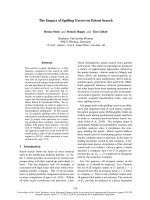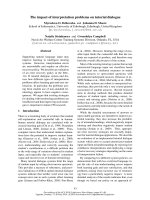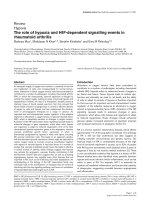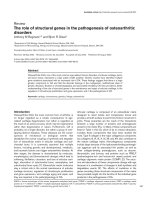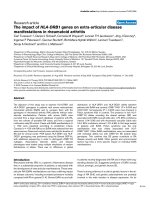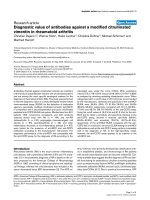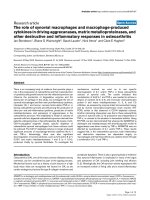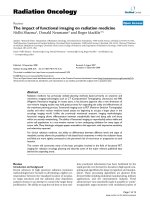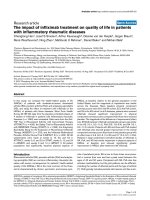Báo cáo y học: "The impact of HLA-DRB1 genes on extra-articular disease manifestations in rheumatoid arthritis" doc
Bạn đang xem bản rút gọn của tài liệu. Xem và tải ngay bản đầy đủ của tài liệu tại đây (213.12 KB, 8 trang )
Open Access
Available online />R1386
Vol 7 No 6
Research article
The impact of HLA-DRB1 genes on extra-articular disease
manifestations in rheumatoid arthritis
Carl Turesson
1,2
, Daniel J Schaid
3
, Cornelia M Weyand
4
, Lennart TH Jacobsson
1
, Jörg J Goronzy
4
,
Ingemar F Petersson
5
, Gunnar Sturfelt
6
, Britt-Marie Nyhäll-Wåhlin
5
, Lennart Truedsson
7
,
Sonja A Dechant
2
and Eric L Matteson
2
1
Department of Rheumatology, Malmö University Hospital, Södra Förstadsgatan 101, 205 02 Malmö, Sweden
2
Division of Rheumatology, Mayo Clinic College of Medicine, 200 First Street SW, Rochester, Minnesota 55905, USA
3
Department of Health Sciences Research, Mayo Clinic College of Medicine, 200 First Street SW, Rochester, Minnesota 55905, USA
4
Lowance Center for Human Immunology, Emory University School of Medicine, 101 Woodruff Circle, Atlanta, Georgia 30322, USA
5
Spenshult Hospital for Rheumatic Diseases, 313 92 Oskarström, Sweden
6
Department of Rheumatology, Lund University Hospital, Kioskgatan 3, 221 85 Lund, Sweden
7
Department of Clinical Microbiology and Immunology, Lund University Hospital, Sölvegatan 23, 223 62 Lund, Sweden
Corresponding author: Carl Turesson,
Received: 27 Jul 2005 Revisions requested: 31 Aug 2005 Revisions received: 6 Sep 2005 Accepted: 8 Sep 2005 Published: 11 Oct 2005
Arthritis Research & Therapy 2005, 7:R1386-R1393 (DOI 10.1186/ar1837)
This article is online at: />© 2005 Turesson et al.; licensee BioMed Central Ltd.
This is an Open Access article distributed under the terms of the Creative Commons Attribution License />,
which permits unrestricted use, distribution, and reproduction in any medium, provided the original work is properly cited.
Abstract
The objective of this study was to examine HLA-DRB1 and
HLA-DQB1 genotypes in patients with severe extra-articular
rheumatoid arthritis (ExRA) and to compare them with the
genotypes of rheumatoid arthritis (RA) patients without extra-
articular manifestations. Patients with severe ExRA were
recruited from a large research database of patients with RA,
from two cohorts of prevalent RA cases, and from a regional
multicenter early RA cohort. Cases with ExRA manifestations (n
= 159) were classified according to predefined criteria.
Controls (n = 178) with RA but no ExRA were selected from the
same sources. Cases and controls were matched for duration of
RA and for clinical center. PCR based HLA-DRB1 and HLA-
DQB1 genotyping was performed using the Biotest SSP kit,
with additional sequencing in order to distinguish DRB1*04
subtypes. Associations between alleles and disease
phenotypes were tested using multiple simulations of random
distributions of alleles. There was no difference in global
distribution of HLA-DRB1 and HLA-DQB1 alleles between
patients with ExRA and controls. DRB1*0401 (P = 0.003) and
0401/0401 homozygosity (P = 0.002) were more frequent in
Felty's syndrome than in controls. The presence of two HLA-
DRB1*04 alleles encoding the shared epitope (SE) was
associated with ExRA (overall odds ratio 1.79, 95% confidence
interval 1.04–3.08) and with rheumatoid vasculitis (odds ratio
2.44, 95% confidence interval 1.22–4.89). In this large sample
of patients with ExRA, Felty's syndrome was the only
manifestation that was clearly associated with HLA-
DRB1*0401. Other ExRA manifestations were not associated
with individual alleles but with DRB1*04 SE double dose
genotypes. This confirms that SE genes contribute to RA
disease severity and ExRA. Other genetic and environmental
factors may have a more specific impact on individual ExRA
manifestations.
Introduction
Rheumatoid arthritis (RA) is a systemic inflammatory disease
that, in a substantial proportion of patients, is associated with
the development of extra-articular manifestations. These extra-
articular RA (ExRA) manifestations can have a defining impact
on disease outcome, including increased premature mortality
compared with RA in general [1-4]. Severe ExRA occurs both
in patients recently diagnosed with RA and in those with long-
standing disease [2]. Suggested predictors of ExRA include
clinical, serologic, and genetic factors [5].
There is strong evidence of a role for genetic factors in the eti-
ology of RA [6-8], and genetic polymorphisms are probably
involved in the wide variation in disease expression. As for
ANA = antinuclear antibody; CI = confidence interval; ExRA = extra-articular rheumatoid arthritis; HLA = human leukocyte antigen; MHC = major
histocompatibility complex; OR = odds ratio; PCR = polymerase chain reaction; RF = rheumatoid factor; SE = shared epitope.
Arthritis Research & Therapy Vol 7 No 6 Turesson et al.
R1387
most diseases classified according to a list of criteria, rather
than specific diagnostic tests, the disease phenotype in RA is
heterogeneous. The presence of disease susceptibility alleles
may define subsets of patients with different disease courses,
including patients with mild, nonerosive disease and those
with a true RA phenotype and progressive disease, with exten-
sive joint damage and ExRA manifestations. On the other
hand, genetic markers not related to disease susceptibility
may influence disease progression and risk for developing
ExRA.
HLA (human leukocyte antigen) alleles have been implicated
in a number of chronic inflammatory diseases. RA has been
associated with the 'shared epitope' (SE) of HLA-DRB1,
which includes DRB1*04 and DRB1*01 alleles [9]. Recent
genome-wide scanning studies using microsatellite loci have
confirmed that there is strong linkage between this region and
RA [10,11]. RA-associated HLA-DRB1*04 alleles have been
reported mainly in patients with severe disease [12-16]. A
meta-analysis of studies of disease progression in RA [17]
revealed an association between HLA-DRB1*04 and erosive
disease, and in a recently reported survey of an extensively
investigated cohort of patients with early RA [18] homozygos-
ity for HLA-DRB1*04 was a major predictor of development of
erosions. DRB1*04 alleles have also been specifically associ-
ated with ExRA [19-21], and a specific impact of DRB1*04
homozygosity has been suggested. Some authors have
reported an association with the 0401/0401 genotype
[21,22] whereas others have found the 0401/0404 genotype
to be more frequent among patients with ExRA [23]. These
discrepancies may reflect variability in the relative frequencies
of HLA-DRB1*0401 in different populations. For example, in
East Asian populations, in which DRB1*0401 is rare and
DRB1*0405 is the most frequent RA associated HLA-DRB1
genotype [24], the latter allele has also been reported to be
associated with an increased risk for ExRA manifestations
[25].
All previous studies of major histocompatibility class (MHC)
class II genes and ExRA have been based on small patient
samples, limiting the generalizability of the results. Most stud-
ies were not sufficiently powered to examine the effect of link-
age disequilibrium within the MHC, including HLA-DQB1
alleles. Previous investigations did not use consistent and well
characterized definitions of ExRA, which is a matter of vital
importance to the study of disease phenotypes in RA [26].
The purpose of this study was to investigate associations
between HLA-DRB1 and HLA-DQB1 alleles and severe
ExRA manifestations in a multicenter case-control study of
patients with well characterized disease. To our knowledge,
this is the largest sample of patients with severe ExRA ever
reported. We report that patients with ExRA manifestations
are more likely to carry a double dose of DRB1*04 SE alleles,
and we demonstrate that the impact of individual DRB1 alleles
is limited.
Materials and methods
Patients
Patients with severe ExRA according to predefined criteria
[2,3] were recruited from the rheumatology laboratory data-
base of the Mayo Clinic (Rochester, MN, USA), from two
clinic-based cohorts of patients with ExRA from Malmö Univer-
sity Hospital and Lund University Hospital (Sweden), and from
a Swedish multicenter early RA cohort (the Better AntiRheu-
matic PharmacOTherapy [BARFOT] cohort). ExRA manifesta-
tions studied included pericarditis, pleuritis, Felty's syndrome,
scleritis, episcleritis, glomerulonephritis, vasculitis-related neu-
ropathy, major cutaneous vasculitis, and vasculitis involving
other organs. Felty's syndrome was defined as RA-associated
neutropenia and splenomegaly, with other potential causes
excluded or unlikely. In addition, the criteria for severe ExRA
were modified to include RA-associated interstitial lung dis-
ease, as previously described [5]. Controls, defined as
patients with RA without current or previous signs of extra-
articular disease manifestations, in accordance with the same
criteria [2,3,5], were selected from the corresponding centers.
One patient with RA (control) was matched to each patient
with ExRA (case) according to duration of RA and clinical
center. All cases and controls fulfilled 1987 American College
of Rheumatology criteria for classification of RA [27].
Eighty-eight patients fulfilling the predefined criteria for ExRA
(see above) were identified from the Mayo Clinic rheumatology
laboratory database, and their medical case records were sub-
jected to a structured review, as previously described [22]. A
random sample of 184 patients with RA but without ExRA
were identified from this database after careful medical record
review. Controls from this sample were matched with cases
for duration of RA ± 5 years. DNA samples were available from
86 ExRA cases and 85 controls for HLA typing.
Another cohort of patients was recruited from a prospective
study of extra-articular disease manifestations and vascular
comorbidities in RA from the rheumatology outpatient clinic of
Malmö University Hospital. Consecutive patients with recently
diagnosed severe extra-articular disease manifestations were
invited to participate. Patients with non-extra-articular RA,
matched to extra-articular patients for age, sex and disease
duration (± 1 year), were selected from a community-based
register of RA patients in the city of Malmö [28] or from a com-
munity-based early RA inception cohort from the same area.
Samples from 28 patients with ExRA (cases) and 28 matched
patients with RA but without ExRA (controls) were available for
analysis. Thirty-five patients with ExRA (cases) and 42 patients
with RA but without extra-articular disease (controls), matched
for disease duration, from a case-control study of predictors of
ExRA at the University Hospitals in Malmö and Lund [22] were
also included in the analysis. Results of HLA-DR and HLA-DQ
Available online />R1388
genotyping for some of these patients were reported previ-
ously [22].
In addition, patients were recruited from the BARFOT registry
[29], which includes patients participating in a structured pro-
gram for follow up of newly diagnosed RA in southern Swe-
den. This registry includes virtually all adult patients with new
onset of inflammatory polyarthritis within the catchment area of
the six participating rheumatology centers of the BARFOT pro-
gram (total population is approximately 1.5 million), including
patients fulfilling the 1987 American College of Rheumatology
classification criteria for RA [27]. From 1992 to 2001, a total
of 1,589 consecutive patients were recruited to the registry.
Referring rheumatologists are encouraged to report ExRA
manifestations occurring in these patients to the register. All
reported ExRA cases (n = 35) were reviewed and classified
according to the study criteria [2,3]. Of these, 26 patients ful-
filled the criteria for ExRA. Controls without ExRA were
matched to the cases by sex, age at inclusion, disease dura-
tion and, when possible, geographic region. All potential con-
trols were reviewed in order to ensure that they did not have a
history of ExRA. Samples for genotyping were available from
ten ExRA cases and 24 non-ExRA controls in this subset.
Data on serologic tests for rheumatoid factor (RF) and antinu-
clear antibodies (ANAs), and information on smoking status
are prospectively collected as part of a structured follow up of
patients in the BARFOT study. Data on these parameters for
patients from the other centers (Malmö, Lund and the Mayo
Clinic) were obtained by thorough review of all available clini-
cal records.
All patients gave informed consent to participate in the study.
The study was approved by the Research Ethics Committee at
Lund University and by the Institutional Review Board at the
Mayo Clinic.
Genotyping
DNA for HLA-DRB1/DQB1 typing of patients recruited from
the Mayo Clinic was isolated from peripheral blood mononu-
clear cells using the DNA Isolation Kit for Mammalian Blood
(Roche Applied Sciences, Indianapolis, IN, USA). For patients
from the Swedish RA cohorts, DNA was extracted from whole
blood using the QIAamp minikit (Qiagen, Hilden, Germany) at
the DNA/RNA Genotyping Laboratory, SWEGENE Resource
Center for Profiling Polygenic Diseases (Lund University and
Malmö University Hospital, Sweden). The purified DNA was
used for HLA-DRB1 and HLA-DQB1 determination with the
PCR-based Micro-SSP DRB and DQB generic typing trays
(Biotest AG, Dreiech, Germany). Because the DRB kit does
not detect HLA-DRB1*04 allelic variations, all samples that
were positive for HLA-DRB1*04 were re-amplified by PCR
using a primer set that amplified all HLA-DRB1*04 alleles: 5'-
GTTTCTTGGAGCAGGTTAAACA-3' (HLA-DRB1*04) and
5'-GCCGCTGCACTGTGAAGCTCTC-3' (HLA-DRB1
generic). Samples were then purified using the High Pure
PCR Product Purification Kit (Roche Applied Sciences) and
sequenced in the Mayo Clinic molecular biology core facility
on a PRISM 37 DNA Sequencer (Applied Biosystems, Foster
City, CA, USA) with the HLA-DRB1 primer as the initiating
primer. The specific HLA-DRB1*04 allele was then assigned
on the basis of the sequencing results. For the statistical anal-
ysis, the SE encoding rare DRB1*0401-like alleles *0409,
*0413, *0416 and *0421 were classified as *0401; alleles
*0408, *0410 and *0419 were classified as *0404. The
DRB1*0405 alleles were analyzed as a separate entity. All
other DRB1*04 alleles were classified as DRB1*04 non-SE
alleles.
Statistical analysis
The age at RA diagnosis and the duration of RA at inclusion in
ExRA cases and non-ExRA controls with RA were compared
using the t test. The sex distribution, the number of smokers
and the number of patients with a positive RF test or ANA test
at any time were compared between the cases and controls
using Pearson's χ
2
statistic.
To compare the distribution of alleles between cases and con-
trols, we used Armitage's trend in proportions, which does not
treat the two alleles within a person as independent (i.e. it
does not assume Hardy-Weinberg equilibrium). This approach
reduces to the usual Pearson χ
2
statistic for comparing allele
frequencies when genotype proportions match Hardy-Wein-
berg proportions [30], and is the preferred way to compare
allele frequencies [31]. However, the usual Armitage test for
trend is for only two alleles. A multivariate extension for more
than two alleles, which compares allele counts between cases
and controls, is based on the score statistic for logistic regres-
sion. For this score statistic, each subject receives a vector of
scores, where each element of the vector counts alleles of
each type. From this score statistic, we computed a global test
of association between case/control status and all alleles of
Table 1
Demographic data and clinical predictors of ExRA
ExRA Non-ExRA P
Number 159 178
Age at RA diagnosis
(years; mean ± SD)
50.1 ± 14.4 50.4 ± 14.8 0.87
Disease duration (years;
mean ± SD)
11.3 ± 11.2 12.5 ± 11.3 0.34
Male/female (n) 75/84 66/112 0.06
RF positive
a
(%) 87.2 58.3 <0.0001
ANA positive
b
(%) 60.8 33.8 <0.0001
a
Information available for 149 extra-articular rheumatoid arthritis
(ExRA) and 163 non-ExRA patients.
b
Information available from 120 ExRA and 151 non-ExRA patients.
ANA, antinuclear antibody; RA, rheumatoid arthritis; RF, rheumatoid
factor; SD, standard deviation.
Arthritis Research & Therapy Vol 7 No 6 Turesson et al.
R1389
HLA-DRB1 and HLA-DQB1 separately. Because the distribu-
tion of this statistic is not known, we performed simulations to
compute P values. The case/control status was randomly per-
muted, and the simulated statistic computed and compared
with the observed statistic. This simulation process was
repeated 1,000 times to compute P values, both for the maxi-
mum statistic and allele-specific Armitage trend tests. The dis-
tribution of combinations of HLA-DRB1 and DQ alleles (i.e.
the distribution of HLA-DRB1-DQ haplotypes) was similarly
compared in cases and controls.
To evaluate the association of single or double dose of HLA-
DRB1*04 SE subtypes with case/control status, or with a par-
ticular manifestation of ExRA, we used logistic regression to
calculate odds ratios (ORs) and 95% confidence interval (CI).
Results
A total of 159 patients with severe ExRA according to prede-
fined criteria [5,23] were identified. Forty-three patients had
vasculitis, defined as biopsy proven vasculitis or major cutane-
ous vasculitis diagnosed by a dermatologist. Additional sub-
groups analyzed were neuropathy (mononeuropathy or
polyneuropathy; n = 40), interstitial lung disease (n = 25),
Felty's syndrome (n = 21) and pericarditis (n = 27). These
were compared with 178 controls with non-extra-articular RA.
Disease duration and age at RA onset was similar in cases and
controls (mean 11.3 years versus 12.5 years for duration, and
mean 50.1 years versus 50.4 years for age at RA onset; Table
1). There was a trend toward a relative predominance of male
patients in the ExRA group (P = 0.06). However, this compar-
ison is skewed because of the matching of cases and controls
for sex in two of the subsamples. A positive test for RF (P <
0.0001) or ANAs (P < 0.0001) at any time were both signifi-
cantly associated with ExRA.
Some of the individual severe ExRA manifestations occurred
together more frequently than expected. Among the 21
patients with Felty's syndrome, three (14%) had evidence of
vasculitis. In the subset with vasculitis, 15 out of 43 (35%) had
neuropathy and seven (16%) had interstitial lung disease.
Overall effects of HLA-DRB1 alleles
The distribution of HLA-DRB1 was not significantly different
between ExRA cases and non-ExRA controls (global P = 0.19;
Table 2). The most frequent HLA-DRB1 allele in both groups
was HLA-DRB1*0401, and this allele tended to be more com-
mon among patients with ExRA (allele frequency 0.326 versus
0.263; P = 0.09). HLA-DRB1*0401 was significantly associ-
ated with Felty's syndrome (allele frequency 0.475; P = 0.003)
but not with other individual manifestations when compared
with non-extra-articular RA (Fig. 1). The rare allele HLA-
DRB1*12 was more common in the ExRA subgroup (allele fre-
quency 0.023 versus 0.003; P = 0.02). The DRB1*0405
(allele frequency 0.019 versus 0.003; P = 0.01) and
DRB1*0404 (allele frequency 0.119 versus 0.085; P = 0.14)
alleles were also more frequent in patients with ExRA than in
non-ExRA controls. One of the HLA-DRB1*04 alleles encod-
ing the SE (DRB1*0401, *0404, or *0405) was present in
105 out of 151 ExRA patients as compared with 96 out of 178
Table 2
Frequencies of HLA-DRB1 alleles in patients with ExRA
compared with patients with non-extra-articular RA
HLA-DRB1 allele Allele frequency P
ExRA Non-ExRA
DRB1*01 0.119 0.130 0.74
DRB1*03 0.071 0.113 0.12
DRB1*0401 0.326 0.263 0.09
DRB1*0404 0.119 0.085 0.14
DRB1*0405 0.019 0.003 0.01
Non-SE DRB1*04 0.019 0.045 0.09
DRB1*07 0.052 0.065 0.54
DRB1*08 0.013 0.014 1.00
DRB1*09 0.023 0.011 0.23
DRB1*10 0.016 0.020 0.73
DRB1*11 0.036 0.054 0.28
DRB1*12 0.023 0.003 0.02
DRB1*13 0.042 0.045 0.83
DRB1*15 0.097 0.110 0.65
Global: P = 0.19. ExRA, extra-articular rheumatoid arthritis; SE,
shared epitope.
Figure 1
Variation in frequency of HLA-DRB1*0401 by disease phenotype in RAVariation in frequency of HLA-DRB1*0401 by disease phenotype in
RA. HLA-DRB1*0401 was significantly more frequent in patients with
Felty's syndrome (P = 0.003) than in non-extra-articular rheumatoid
arthritis (RA) controls, but patients with other manifestations did not dif-
fer significantly from controls. ExRA, extra-articular RA; ILD, interstitial
lung disease; Neuro, vasculitis related neuropathy.
Available online />R1390
non-ExRA patients (OR 1.77, 95% CI 1.13–2.77). The impact
of the presence of DRB1*04 SE alleles on risk for ExRA was
variable for the different manifestations (Fig. 2). Patients with
RA and vasculitis were more likely to carry DRB1*04 SE alle-
les than patients with RA and no vasculitis (OR 2.07, 95% CI
1.00–4.25). Similar trends were found for Felty's syndrome
and neuropathy, but the associations were not significant (Fig.
2).
Effects of homozygosity for the shared epitope
The homozygous genotype HLA-DRB1*0401/0401 was sig-
nificantly more frequent in patients with Felty's syndrome
(genotype frequency 0.286; P = 0.002) and patients with peri-
carditis (genotype frequency 0.185; P = 0.043) than in non-
ExRA controls (frequency 0.068). Other ExRA manifestations
were not associated with any specific homozygous genotype.
The presence of two HLA-DRB1*04 SE alleles was signifi-
cantly associated with ExRA overall (OR 1.79, 95% CI 1.04–
3.08), Felty's syndrome (OR 2.63, 95% CI 1.04–6.63), and
vasculitis (OR 2.44, 95% CI 1.22–4.89) compared with
patients with RA who lacked these manifestations. By con-
trast, pericarditis, neuropathy, and interstitial lung disease
were not associated with double dose of HLA-DRB1*04 SE
alleles (Table 3).
Effects of HLA-DQB alleles
The distribution of HLA-DQB alleles was not significantly dif-
ferent between ExRA cases and non-ExRA controls (P = 0.11;
Table 4). The relatively rare allele HLA-DQ4 tended to occur
more frequently in ExRA cases (allele frequency 0.046 versus
0.014; P = 0.037). Other than that, there was no significant
difference in the occurrence of DQB alleles between patients
with ExRA overall or individual ExRA manifestations and non-
ExRA controls. There was no significant global difference in
the frequency of homozygous HLA-DQB genotypes between
cases and controls except for patients with ExRA and pericar-
ditis (P = 0.04). HLA-DQ8/DQ8 homozygosity was more
common in patients with pericarditis than in non-ExRA patients
with RA (genotype frequency 0.120 versus 0.029; P = 0.021).
Analyses of linkage disequilibrium
Haplotype analysis indicated that the association between
ExRA and HLA-DRB1*04 SE homozygosity was due to the
importance of the DRB1*04 genotype, rather than being
secondary to associations with HLA-DRB1-DQB haplotypes
(data not shown). Similarly, the associations between Felty's
syndrome and DRB1*0401, and between pericarditis and
DQ8/DQ8 were not explained by DRB1-DQB haplotype
associations.
Discussion
In this large sample of patients with severe ExRA, we found
Felty's syndrome to be associated with HLA-DRB1*0401.
There was no significant difference in the global distribution of
HLA-DRB1 or HLA-DQB alleles compared with non-extra-
articular RA controls for any other manifestation or for ExRA
overall. Patients with severe ExRA were more likely to carry
HLA-DRB1*04 SE alleles, and genotypes featuring a double
dose of DRB1*04 SE alleles were associated with rheumatoid
vasculitis, Felty's syndrome, and all ExRA combined.
A number of studies have indicated a role for HLA-DR4
related genes in ExRA [26]. In Caucasians of Northern Euro-
pean origin, severe ExRA has been associated with
DRB1*0401/0401 homozygosity in particular [21,22]. In a
recent meta-analysis of HLA-DRB1 genotyping studies of
patients with RA-associated vasculitis conducted by Gorman
and coworkers [32], vasculitis was found to be associated
with the genotypes 0401/0401, 0401/0404, and 0401/0101.
In other meta-analyses by the same group, double dose of
DRB1*04 SE alleles was associated with radiographic signs
of progressive joint damage in northern European Caucasians
[17], but there was no significant association between SE and
the presence of rheumatoid nodules [33]. Taken together,
these findings indicate that DRB1*04 SE double gene dose is
associated with disease severity in RA, and that such geno-
types may contribute specifically to risk for severe ExRA
manifestations.
On the other hand, there was considerable heterogeneity
across individual ExRA manifestations. The association
between Felty's syndrome and DRB1*0401 is well
established [34,35]. In contrast, we did not observe any signif-
icant association with single or double DRB1*04 gene dose
for patients with pericarditis, neuropathy, or interstitial lung dis-
ease. This indicates that the importance of HLA-DRB1 alleles
may be variable for different manifestations, although our fail-
ure to detect an effect could be due to sample size or
selection.
Severe ExRA manifestations tend to cluster in individual
patients with RA [36]. The high prevalence of vasculitis in
patients with Felty's syndrome observed in the present study
is consistent with the literature [37], and may in part be due to
shared genetic factors such as HLA-DRB1*04 alleles. In a
Figure 2
ExRA manifestations among those carrying carrying HLA-DRB1*04 shared epitope allelesExRA manifestations among those carrying carrying HLA-DRB1*04
shared epitope alleles. Shown are odds ratios (ORs) with 95% confi-
dence intervals (CIs) for different extra-articular rheumatoid arthritis
(ExRA) manifestations for patients carrying HLA-DRB1*04 shared
epitope alleles. ILD, interstitial lung disease.
Arthritis Research & Therapy Vol 7 No 6 Turesson et al.
R1391
survey of the community-based Olmsted county RA cohort
[36] we found clustering of a number of different ExRA fea-
tures, including a frequent co-occurrence of vasculitis with
neuropathy and rheumatoid lung disease. We made similar
observations in the present study. Such clustering may be
explained by both genetic and environmental factors.
The association between HLA-DRB1 genotypes and RA dis-
ease severity, including ExRA, has been interpreted as reflect-
ing the importance of T cells in the pathogenesis of RA [26].
HLA-DR and other MHC molecules are involved in presenta-
tion of antigens to T cells, and in positive and negative selec-
tion of T cells in the thymus. Because there appears to be a
stoichiometric relationship between MHC molecules on the
cell surface and positive selection mechanisms in thymic mat-
uration of T cells, it has been suggested that the explanation
for the gene dose effect seen in ExRA is its effect on T-cell
diversity [21,38]. The T-cell repertoire in patients with RA is
markedly contracted, with less diversity and emergence of
dominant T-cell clonotypes [39]. T-cell abnormalities in
patients with ExRA include expansion of CD8
+
large granular
lymphocytes [40] and of immunosenescent CD4
+
CD28
-
cells
[41,42], and extensive CD4
+
infiltrates in RA-associated inter-
stitial pneumonitis [43]. The importance of HLA-DRB1 genes
and other genes with a role in T-cell selection and T-cell func-
tion for these phenomena require further study.
In accordance with previous studies, we found patients with
ExRA to be more likely to be RF positive and ANA positive
[22,44]. This suggests a role for both B cells and T cells, pos-
sibly including dysregulated B cell-T cell interaction, in ExRA.
New genetic associations that were not postulated and have
not been reproduced should be interpreted with caution.
Given the nonsignificant results of the global distribution tests,
the associations between ExRA and some rare DRB1 and
DQB1 alleles (i.e. DRB1*12 and DQ4) are probably due to
chance. The negative global test for HLA-DRB1 alleles in
ExRA overall also suggests that the impact of DRB1*04 SE on
the risk for severe ExRA manifestations is not strong, although
it is reproducible in separate patient samples.
The lack of association between ExRA and HLA-DQB1 alle-
les, and the lack of association with HLA-DRB1-DQB1 haplo-
types favors a specific role for HLA-DRB1 genes in ExRA,
rather than secondary associations due to linked genes. Nev-
ertheless, we cannot exclude the possibility that linkage dise-
quilibrium with other genes in MHC explain our results.
The patients included in this study were recruited from four dif-
ferent centers, and the background RA population from which
they were sampled is not fully characterized, at least not for the
patients seen at Lund University Hospital and at the Mayo
Clinic. On the other hand, these patients were recruited during
a period when there was particular interest in patients with
severe ExRA at each of the centers, suggesting that they
Table 3
The effect of homozygosity for HLA-DRB1*04 shared epitope alleles on risk for severe ExRA manifestations
Manifestations Homozygotes (yes/no; %) OR (95% CI) P
Cases with manifestation Controls without
manifestation
All ExRA 39/116 (25) 28/149 (16) 1.79 (1.04–3.08) 0.04
Pericarditis 8/19 (29) 59/246 (19) 1.76 (0.73–4.19) 0.21
Felty's syndrome 8/13 (38) 59/252 (19) 2.63 (1.04–6.63) 0.04
Neuropathy 8/32 (20) 59/233 (20) 0.99 (0.43–2.25) 0.98
Interstitial lung disease 3/22 (12) 64/243 (21) 0.52 (0.15–1.78) 0.30
Vasculitis 15/28 (35) 52/237 (18) 2.44 (1.22–4.89) 0.01
CI, confidence interval; ExRA, extra-articular rheumatoid arthritis; OR, odds ratio.
Table 4
Frequencies of HLA-DQ alleles in patients with ExRA compared
with patients with non-extra-articular RA
HLA-DQ allele Allele frequency P
ExRA Non-ExRA
DQ2 0.122 0.121 0.91
DQ3 0.017 0.029 0.50
DQ4 0.046 0.014 0.04
DQ5 0.129 0.188 0.06
DQ6 0.139 0.165 0.37
DQ7 0.252 0.249 1.00
DQ8 0.222 0.170 0.13
DQ9 0.066 0.043 0.22
Global: P = 0.11. ExRA, extra-articular RA.
Available online />R1392
should reflect the majority of patients with ExRA seen and be
representative of the ExRA population as a whole.
In multicenter studies of genetic markers, ethnic heterogeneity
of the studied patient samples must be considered. However,
the majority of the patients included at the Mayo Clinic were
Caucasians of northern European origin, similar to the patients
from southern Sweden. Thus, our result could be generalized
to RA patients with this ethnic background but not to other
populations.
Conclusion
In a study of a large sample of patients with ExRA, we have
confirmed an association between HLA-DRB1*0401 and
Felty's syndrome, but we found no association between ExRA
overall or other individual manifestations and specific HLA-
DRB1 alleles. Double dose HLA-DRB1*04 SE genotypes are
associated with a modestly increased risk for vasculitis and
other ExRA manifestations. Other genetic and environmental
factors are likely to be more important for the systemic features
of RA.
Competing interests
The authors declare that they have no competing interests.
Authors' contributions
CT conceived the study, was responsible for the recruitment
and classification of patients, and drafted the manuscript. DS
performed the statistical analysis and helped to draft the man-
uscript. CW participated in the design and coordination of the
study, and recruited a subset of the patients. LJ participated in
the recruitment of a subset of the patients and the interpreta-
tion of the statistical data, and helped to draft the manuscript.
JG recruited a subset of the patients and participated in the
design and coordination of the study. GS participated in the
recruitment of patients and the molecular genetics analysis. IP
participated in the recruitment of patients, the extraction of
clinical data, and the interpretation of the statistical analysis.
BMNW participated in the recruitment and classification of
patients and the extraction of clinical data. LT performed part
of the molecular genetics analysis and helped to draft the
manuscript. SD performed part of the molecular genetics anal-
ysis and participated in the coordination of the study. EM
conceived the study together with CT, performed part of the
molecular genetics analysis, participated in the design and
coordination of the study, and in the interpretation of the sta-
tistical data, and helped to draft the manuscript. All authors
read and approved the final manuscript.
Acknowledgements
The authors would like to thank Angelina Lippert for excellent work with
the genotyping. We also thank the BARFOT study group for their sup-
port and for contributing patients to the study, and all colleagues at the
Mayo Clinic, Malmö University Hospital, Lund University Hospital, Spen-
shult Hospital for Rheumatic Diseases, Karolinska University Hospital,
Huddinge, and at the general hospitals in Helsingborg, Kalmar, Kristian-
stad and Mölndal for their help in patient recruitment. This study was
supported by NIH grant K24 AR 47578-01A1, the Swedish Rheuma-
tism Association, the Swedish Society for Medicine, Lund University,
and a grant from the Mayo Clinic.
References
1. Gordon DA, Stein JL, Broder I: The extra-articular features of
rheumatoid arthritis. A systematic analysis of 127 cases. Am J
Med 1973, 54:445-452.
2. Turesson C, Jacobsson L, Bergstrom U: Extra-articular rheuma-
toid arthritis: prevalence and mortality. Rheumatology (Oxford)
1999, 38:668-674.
3. Turesson C, O'Fallon WM, Crowson CS, Gabriel SE, Matteson
EL: Occurrence of extraarticular disease manifestations is
associated with excess mortality in a community based cohort
of patients with rheumatoid arthritis. J Rheumatol 2002,
29:62-67.
4. Gabriel SE, Crowson CS, Kremers HM, Doran MF, Turesson C,
O'Fallon WM, Matteson EL: Survival in rheumatoid arthritis: a
population-based analysis of trends over 40 years. Arthritis
Rheum 2003, 48:54-58.
5. Turesson C, Jacobsson LT: Epidemiology of extra-articular
manifestations in rheumatoid arthritis. Scand J Rheumatol
2004, 33:65-72.
6. Aho K, Koskenvuo M, Tuominen J, Kaprio J: Occurrence of rheu-
matoid arthritis in a nationwide series of twins. J Rheumatol
1986, 13:899-902.
7. Silman AJ, MacGregor AJ, Thomson W, Holligan S, Carthy D,
Farhan A, Ollier WE: Twin concordance rates for rheumatoid
arthritis: results from a nationwide study. Br J Rheumatol
1993, 32:903-907.
8. Grant SF, Thorleifsson G, Frigge ML, Thorsteinsson J, Gunnlaugs-
dottir B, Geirsson AJ, Gudmundsson M, Vikingsson A, Erlendsson
K, Valsson J, et al.: The inheritance of rheumatoid arthritis in
Iceland. Arthritis Rheum 2001, 44:2247-2254.
9. Gregersen PK, Silver J, Winchester RJ: The shared epitope
hypothesis. An approach to understanding the molecular
genetics of susceptibility to rheumatoid arthritis. Arthritis
Rheum 1987, 30:1205-1213.
10. Jawaheer D, Seldin MF, Amos CI, Chen WV, Shigeta R, Monteiro
J, Kern M, Criswell LA, Albani S, Nelson IL, et al.: A genomewide
screen in multiplex rheumatoid arthritis families suggests
genetic overlap with other autoimmune diseases. Am J Hum
Genet 2001, 68:927-936.
11. Jawaheer D, Seldin MF, Amos CI, Chen WV, Shigeta R, Etzel C,
Damle A, Xiao X, Chen D, Lum RF, et al.: Screening the genome
for rheumatoid arthritis susceptibility genes: a replication
study and combined analysis of 512 multicase families. Arthri-
tis Rheum 2003, 48:906-916.
12. Weyand CM, Hicok KC, Conn DL, Goronzy JJ: The influence of
HLA-DRB1 genes on disease severity in rheumatoid arthritis.
Ann Intern Med 1992, 117:801-806.
13. Gough A, Faint J, Salmon M, Hassell A, Wordsworth P, Pilling D,
Birley A, Emery P: Genetic typing of patients with inflammatory
arthritis at presentation can be used to predict outcome.
Arthritis Rheum 1994, 37:1166-1170.
14. Weyand CM, McCarthy TG, Goronzy JJ: Correlation between
disease phenotype and genetic heterogeneity in rheumatoid
arthritis. J Clin Invest 1995, 95:2120-2126.
15. Salvarani C, Macchioni PL, Mantovani W, Bragliani M, Collina E,
Cremonesi T, Battistel B, Boiardi L: HLA-DRB1 alleles associ-
ated with rheumatoid arthritis in Northern Italy: correlation
with disease severity. Br J Rheumatol 1998, 37:165-169.
16. Combe B, Dougados M, Goupille P, Cantagrel A, Eliaou JF, Sibilia
J, Meyer O, Sany J, Daures JP, Dubois A: Prognostic factors for
radiographic damage in early rheumatoid arthritis: a multipa-
rameter prospective study. Arthritis Rheum 2001,
44:1736-1743.
17. Gorman JD, Lum RF, Chen JJ, Suarez-Almazor ME, Thomson G,
Criswell LA: Impact of shared epitope genotype and ethnicity
on erosive disease: a meta-analysis of 3,240 rheumatoid
arthritis patients. Arthritis Rheum 2004, 50:400-412.
18. Goronzy JJ, Matteson EL, Fulbright JW, Warrington KJ, Chang-
Miller A, Hunder GG, Mason TG, Nelson AM, Valente RM, Crow-
Arthritis Research & Therapy Vol 7 No 6 Turesson et al.
R1393
son CS, et al.: Prognostic markers of radiographic progression
in early rheumatoid arthritis. Arthritis Rheum 2004, 50:43-54.
19. Ollier W, Venables PJ, Mumford PA, Maini RN, Awad J, Jaraque-
mada D, D'Amaro J, Festenstein H: HLA antigen associations
with extra-articular rheumatoid arthritis. Tissue Antigens 1984,
24:279-291.
20. Hillarby MC, Clarkson R, Grennan DM, Bate AS, Ollier W, Sanders
PA, Chattophadhyay C, Davis M, O'Sullivan MM, Williams B:
Immunogenetic heterogeneity in rheumatoid disease as illus-
trated by different MHC associations (DQ, Dw and C4) in artic-
ular and extra-articular subsets. Br J Rheumatol 1991, 30:5-9.
21. Weyand CM, Xie C, Goronzy JJ: Homozygosity for the HLA-
DRB1 allele selects for extraarticular manifestations in rheu-
matoid arthritis. J Clin Invest 1992, 89:2033-2039.
22. Turesson C, Jacobsson L, Bergstrom U, Truedsson L, Sturfelt G:
Predictors of extra-articular manifestations in rheumatoid
arthritis. Scand J Rheumatol 2000, 29:358-364.
23. Perdriger A, Chales G, Semana G, Guggenbuhl P, Meyer O, Quil-
livic F, Pawlotsky Y: Role of HLA-DR-DR and DR-DQ associa-
tions in the expression of extraarticular manifestations and
rheumatoid factor in rheumatoid arthritis. J Rheumatol 1997,
24:1272-1276.
24. Kim HY, Kim TG, Park SH, Lee SH, Cho CS, Han H: Predomi-
nance of HLA-DRB1*0405 in Korean patients with rheumatoid
arthritis. Ann Rheum Dis 1995, 54:988-990.
25. Koh WH, Chan SH, Lin YN, Boey ML: Association of HLA-
DRB1*0405 with extraarticular manifestations and erosions in
Singaporean Chinese with rheumatoid arthritis. J Rheumatol
1997, 24:629-632.
26. Turesson C, Weyand CM, Matteson EL: Genetics of rheumatoid
arthritis: Is there a pattern predicting extraarticular
manifestations? Arthritis Rheum 2004, 51:853-863.
27. Arnett FC, Edworthy SM, Bloch DA, McShane DJ, Fries JF, Cooper
NS, Healey LA, Kaplan SR, Liang MH, Luthra HS, et al.: The Amer-
ican Rheumatism Association 1987 revised criteria for the
classification of rheumatoid arthritis. Arthritis Rheum 1988,
31:315-324.
28. Jacobsson L, Lindroth Y, Marsal L, Tejler L: [The Malmo model for
private and public rheumatological outpatient care. Coopera-
tion makes it possible to introduce disease modifying treat-
ment quickly]. Lakartidningen 2001, 98:4710-4716.
29. Svensson B, Schaufelberger C, Teleman A, Theander J: Remis-
sion and response to early treatment of RA assessed by the
Disease Activity Score. BARFOT study group. Better Anti-rheu-
matic Farmacotherapy. Rheumatology (Oxford) 2000,
39:1031-1036.
30. Sasieni PD: From genotypes to genes: doubling the sample
size. Biometrics 1997, 53:1253-1261.
31. Devlin B, Roeder K: Genomic control for association studies.
Biometrics 1999, 55:997-1004.
32. Gorman JD, David-Vaudey E, Pai M, Lum RF, Criswell LA: Partic-
ular HLA-DRB1 shared epitope genotypes are strongly associ-
ated with rheumatoid vasculitis. Arthritis Rheum 2004,
50:3476-3484.
33. Gorman JD, David-Vaudey E, Pai M, Lum RF, Criswell LA: Lack of
association of the HLA-DRB1 shared epitope with rheumatoid
nodules: an individual patient data meta-analysis of 3,272
Caucasian patients with rheumatoid arthritis. Arthritis Rheum
2004, 50:753-762.
34. Lanchbury JS, Jaeger EE, Sansom DM, Hall MA, Wordsworth P,
Stedeford J, Bell JI, Panayi GS: Strong primary selection for the
Dw4 subtype of DR4 accounts for the HLA-DQw7 association
with Felty's syndrome. Hum Immunol 1991, 32:56-64.
35. Coakley G, Brooks D, Iqbal M, Kondeatis E, Vaughan R, Loughran
TP Jr, Panayi GS, Lanchbury JS: Major histocompatility complex
haplotypic associations in Felty's syndrome and large granular
lymphocyte syndrome are secondary to allelic association
with HLA-DRB1 *0401. Rheumatology (Oxford) 2000,
39:393-398.
36. Turesson C, Christianson TJH, McClelland RL, Matteson EL: Clus-
tering of extra-articular manifestations in rheumatoid arthritis.
Arthritis Rheum 2004, 51:S243.
37. Schneider HA, Yonker RA, Katz P, Longley S, Panush RS: Rheu-
matoid vasculitis: experience with 13 patients and review of
the literature. Semin Arthritis Rheum 1985, 14:280-286.
38. Weyand CM, Goronzy JJ: Functional domains on HLA-DR mol-
ecules: implications for the linkage of HLA-DR genes to differ-
ent autoimmune diseases. Clin Immunol Immunopathol 1994,
70:91-98.
39. Wagner UG, Koetz K, Weyand CM, Goronzy JJ: Perturbation of
the T cell repertoire in rheumatoid arthritis. Proc Natl Acad Sci
USA 1998, 95:14447-14452.
40. Loughran TP Jr, Starkebaum G: Large granular lymphocyte
leukemia. Report of 38 cases and review of the literature.
Medicine (Baltimore) 1987, 66:397-405.
41. Martens PB, Goronzy JJ, Schaid D, Weyand CM: Expansion of
unusual CD4
+
T cells in severe rheumatoid arthritis. Arthritis
Rheum 1997, 40:1106-1114.
42. Goronzy JJ, Weyand CM: Aging, autoimmunity and arthritis: T-
cell senescence and contraction of T-cell repertoire diversity:
catalysts of autoimmunity and chronic inflammation. Arthritis
Res Ther 2003, 5:225-234.
43. Turesson C, Matteson EL, Colby TV, Vuk-Pavlovic Z, Vassallo R,
Weyand CM, Tazelaar HD, Limper AH: Increased CD4
+
T cell
infiltrates in rheumatoid arthritis-associated interstitial pneu-
monitis compared with idiopathic interstitial pneumonitis.
Arthritis Rheum 2005, 52:73-79.
44. Voskuyl AE, Zwinderman AH, Westedt ML, Vandenbroucke JP,
Breedveld FC, Hazes JM: Factors associated with the develop-
ment of vasculitis in rheumatoid arthritis: results of a case-
control study. Ann Rheum Dis 1996, 55:190-192.

